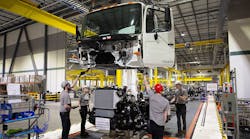Hino officially opened its nearly 1 million sq. ft. production facility in Mineral Wells, WV, on Wednesday, Aug. 22, with a grand opening celebration.
The event, which was shown live on the company’s Facebook page, included a ribbon-cutting ceremony, tree-planting tradition and a Kagami-Wari ceremony to consummate the Japanese-owned company’s growth commitment to the U.S. It also included remarks by West Virginia's governor and members of the state’s Congressional delegation.
In June, Hino’s first truck rolled off the assembly line at the new plant, where it will continue to assemble all Class 6, 7 and 8 conventional trucks, including its newly released Class 7 and 8 XL Series. The new facility can produce 15,000 trucks a year on one shift, which the OEM said will provide it the capacity to continue to grow in the U.S.
“Hino is committed to building its trucks and products in the market it operates in,” said Yoshio Shimo, Hino Motors president and CEO. “We have committed $100 million in capital investment into our new state-of-the-art manufacturing facility, generating 250 new jobs. Today, I am excited to announce an additional commitment of $40M in investment to meet increased demand and product configurations, creating an additional 250 new jobs, totaling 800 team members.”
In the winter of 2018, Hino announced its plans to go big with its new plant when the OEM unveiled its XL Series trucks.
“Entering Class 8 is arguably something no OEM has done successfully over the past 50 years,” Dominik Beckman, Hino’s director of marketing and dealer operations, told a large crowd before the unveiling of the XL7 and XL8 models at the 2018 Work Truck Show in Indianapolis.
Eighteen months later, those trucks are in regular production in Mineral Wells.
Steve Stalnaker, senior vice president of plant operations, said he left West Virginia 30 years ago to pursue career opportunities in manufacturing. “I never envisioned standing here today as part of the Hino team who builds the best medium-duty commercial truck in the U.S. right here in Wood County, W.Va. But thankfully, our parent company HML (Hino Motors Ltd.) had that vision,” he told the crowd at the ceremony.
“Although we produce a world-class vehicle, it took much more for us to double our market share over the past eight years,” he later added. “It required a customer base who has been consistently supportive of Hino products and has consistently championed the value of Hino ownership. Thank you for also providing valuable insight into the needs of the market, which has resulted in strategies to enhance our product line – some of which we're seeing today.”





